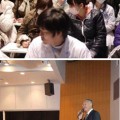Year and site
Type of accident
Radiation source
Contents of the accident
1971 Ichibara
Exposure
Ir-192 (industrial use)
A radiation source for nondestructive inspection was lost; a worker picked it up and brought back to his home. A total of six people who visited the home were exposed
1998 Nagasaki
Exposure
Co-60 (industrial use)
Error in retracting source; a worker directly handled the source for 30–60 s
1998 Okinawa
Exposure
Ir-192 (medical use)
Carelessness in touching the source while changing it
1999 Ibaraki
Criticality accident
Uranium (industrial use)
Exceeding limit value of Uranium solution was poured, and then criticality occurred. Three workers were exposed to γ-rays and neutrons and two of them died
1999–2000 Tokyo
Exposure
LINAC (medical use)
Error in inputting dose to computer which controlled therapeutic dose. 23 patients were exposed with exceeding dose
2000 Chiba
Industrial use Exposure
X-ray machine
Three workers intentionally unlocked safety device and their hands were exposed
2000 Gifu, Ibaraki, Mie, Nagano, Saitama
Witness source
Th-232
Monazite ore containing radioactive tritium had been sprayed on the site and repeated failure to report was discovered
2000 Osaka
Contamination
I-125 (laboratory use)
I-125 has been spread at JR Takatsuki Station
2000 Chiba
Inhalation
Natural uranium
Eight workers inhaled natural uranium in the glass company
2001 Tokyo
Exposure
LINAC (medical use)
A man was working on the ceiling and was accidentally exposed to radiation in generation testing
2001 Iwate
Exposure
X-ray machine (educational institutions)
A teacher used the X-ray equipment to show the bones of fingers to students during a class in a high school and then erythema developed in the hand later
2004 Hokkaido
Contamination
F-18 (medical use)
Dealing with medical radionuclide F-18/H2O, workers were contaminated when they were transferring the nuclide to a plastic bag
2005 Tochigi
Exposure
X-ray machine (industrial use)
In the clean room of an optical equipment company, a worker was accidentally exposed to X-ray from the irradiation device for electrostatic removal of the lens
2008 Ichihara
Case of theft
Ir-192 (industrial use)
A source of nondestructive inspection was stolen and found in the river about 1 month later
2011 Fukushima
Nuclear disaster
I-131, Cs-137, Cs-134, etc.
TEPCO Fukushima Daiichi NPP accident. Large amounts of radionuclides were released to environment and workers, first responders and residents were contaminated and exposed
After the nuclear accident at Three Mile Island of the USA in 1979, the Central Disaster Prevention Council (CDPC) in the Prime Minister’s office reinforced emergency preparedness for dealing with a nuclear power station emergency and issued the report “Urgent Disaster Countermeasures to be taken for Nuclear Facilities by Governmental Agencies” in July 1979. In June 1980, the Nuclear Safety Commission (NSC) of the Japanese government came up with a guideline entitled “Off-site Emergency Planning and Preparedness for Nuclear Power Plants.” According to this guideline, the National Institute of Radiological Sciences (NIRS) was selected as a radiation emergency hospital for receiving victims heavily exposed to radiation and/or contaminated with radionuclides due to nuclear or radiological accidents. Not only radiation accidents at Chernobyl, Ukraine, in 1986 and Goiania, Brazil, in 1987 but also the Great Hanshin-Awaji Earthquake in 1995 and fire and explosion at Bituminization Demonstration Facility of Power Reactor and Nuclear Fuel Development Corporation (PNC), Ibaraki Prefecture, in 1997 necessitated further strengthening of the preparedness and planning. In 1999, a criticality accident occurred; three workers were overexposed to γ-rays and neutrons and two of them died of failure of multiple organs due to acute radiation syndrome (ARS) (Akashi et al. 2001). In 2000, the Basic Plan for Disaster was revised and NSC published a report entitled “The Role of Radiation Emergency Medicine” in 2001 (NSC 2001




Stay updated, free articles. Join our Telegram channel

Full access? Get Clinical Tree





